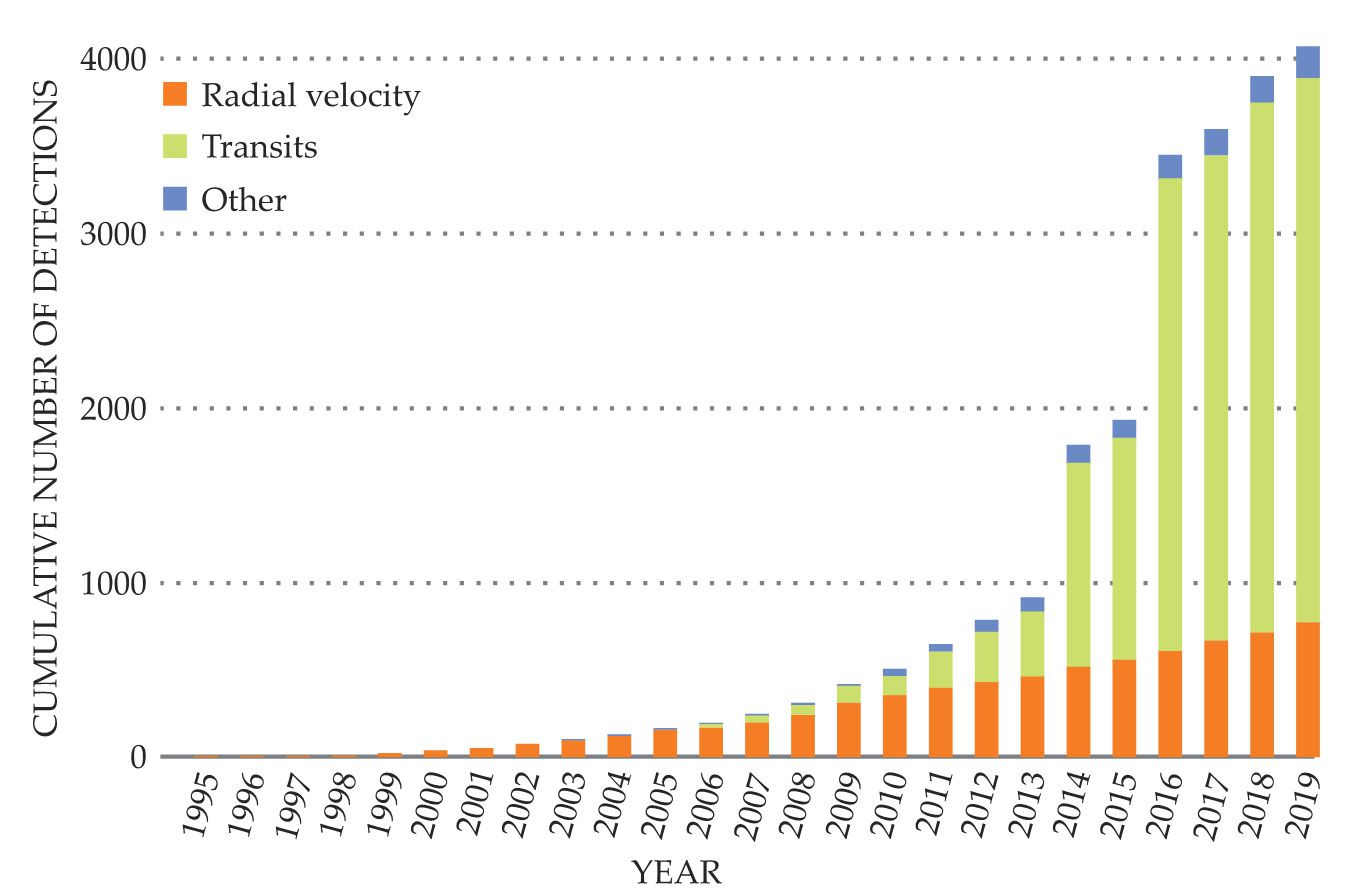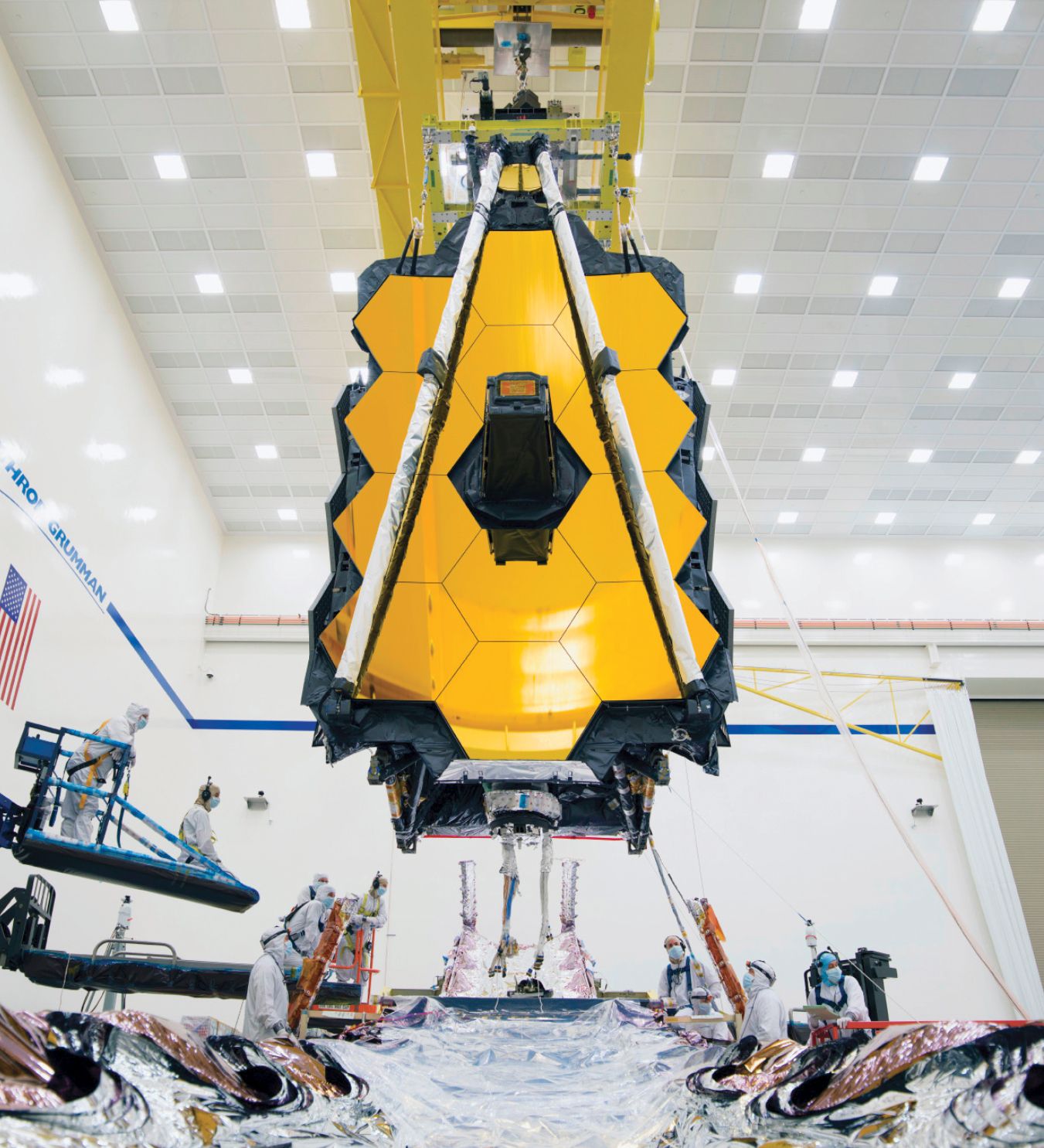Half of Nobel Prize in Physics honors exoplanet trailblazers
DOI: 10.1063/PT.3.4358
Today the number of known planets in the galaxy exceeds 4000. Extrapolating from that figure reveals that the Milky Way harbors more planets than it does stars.
Yet just a quarter century ago, the prospect of conducting such a galactic planet census seemed dim. Although planet-sized bodies had been detected around a neutron star, 1 those objects probably didn’t form the way most planets do, and their dead host star is unlikely to foster an environment conducive to life. The only sunlike star known to host planets was the Sun.
It wasn’t that astronomers didn’t know how to go about looking for extrasolar worlds. By the 1980s a handful of researchers were trying to apply a 19th-century star-velocity measurement technique, known as the radial-velocity (RV) method or Doppler spectroscopy, to search for planet-sized companions.

Didier Queloz and Michel Mayor
EUROPEAN SOUTHERN OBSERVATORY

Focusing on nearby bright stars, the astronomers inspected spectral lines for periodic redshifts and blueshifts stemming from an orbiting planet slightly tugging its host star about their mutual center of gravity. The magnitude of the back-and-forth wobble would depend on the masses of the planet and star, the planet–star distance, and the orientation of the orbital plane as viewed from Earth. Jupiter served as a template: An astute alien observer with a view of our solar system parallel to the ecliptic would notice shifts in the solar spectrum corresponding to a swing in velocity of up to 13 m/s. Although such a shift is detectable, traditionally RV had been used to measure velocities several orders of magnitude higher, such as in the study of binary-star orbits.
After multiple exoplanet discovery claims that proved unconvincing or flat-out wrong, everything changed on 6 October 1995. That’s when Michel Mayor of the University of Geneva joined a panel at a conference in Florence, Italy, and announced that he and graduate student Didier Queloz had discovered 51 Pegasi b, a roughly Jupiter-mass object orbiting the nearby star 51 Pegasi.
Mayor and Queloz had found a Jupiter, but it wasn’t the one anyone expected. Whereas Jupiter’s orbital period is 12 years, 51 Pegasi b completes a revolution around its star every four days; the researchers pegged the planet’s temperature at a sizzling 1300 K. It took several years for the astronomy community to fully embrace the discovery and the challenges it presents to theories of planetary formation. Yet the fact that such hot Jupiters exist, and that they were among the first extrasolar worlds discovered, has had a profound effect on the trajectory of exoplanet science.
Almost 24 years to the day of Mayor’s announcement, the Royal Swedish Academy of Sciences awarded Mayor and Queloz a half share of the 2019 Nobel Prize in Physics. “An entire discipline has been built upon this discovery,” says astrophysicist Natalie Batalha of the University of California, Santa Cruz.
Precision spectroscopy
Like many veteran exoplanet hunters, Mayor began as a stellar astrophysicist. In the 1970s he helped build CORAVEL, a spectrograph used for measuring the orbits of binary stars, tracking the motion of globular clusters, and various other studies. It also proved adept at spotting objects that were considerably less massive than the stars they orbited. In 1989 Mayor was part of a team that presented preliminary evidence 2 for an 11-Jupiter-mass body orbiting the nearby solar-type star HD 114762. The amplitude of the RV signal was about 600 m/s.
The following year Mayor tasked his new student Queloz with designing a spectrograph that could achieve an order of magnitude better precision than CORAVEL. Queloz started by revamping the optics. At the time, the best spectrographs were calibrated by shining light through a cell of hydrogen fluoride or iodine, which would superimpose a set of reference absorption lines onto the stellar spectrum. The approach worked well, but the intensity of the reference source often washed out the spectral features of all but the brightest stars.
Instead, Queloz installed a pair of optical fibers in the spectrograph. One was fed by the reference light of a thorium–argon lamp, the other by starlight. The spectrograph’s separation from the lamp prevented the reference light from flooding the stellar signal, and its separation from the telescope allowed it to be housed in a carefully controlled environment. With that upgrade, plus the use of charge-coupled devices to precisely record the positions of dispersed photons, Mayor and Queloz were able to build a spectrograph with a precision of 13 m/s, right in the ballpark for detecting the RV signals from a Jupiter twin.
In 1994 Mayor and Queloz paired their spectrograph, called ELODIE, with a 1.93 m telescope at the Haute-Provence Observatory in southeast France and began a survey of 142 stars. One target was 51 Pegasi, located about 50 light-years away and in the same spectral class as the Sun. After making observations in September 1994 and January 1995, Queloz noticed an unmistakable periodic signal with an amplitude of nearly 60 m/s and a period of 4.2 days. Mayor was on sabbatical at the time, and the stars in the Pegasus constellation had dipped below the horizon, so Queloz obsessively analyzed the data he had, looking for any explanation aside from a planet. He couldn’t find one.
Queloz presented his case on Mayor’s return, and in July 1995 the two headed to the observatory to see if the tantalizing RV signal persisted. It did. “That’s when we became convinced,” Queloz says. They had strong evidence for a planet at least half the mass of Jupiter with an orbital radius of 0.05 astronomical units—an eighth of Mercury’s average distance from the Sun.
Mayor and Queloz rushed to prepare a paper, which they submitted to Nature in August. 3 Soon after Mayor’s announcement at the October conference, 51 Pegasi b was confirmed by San Francisco State University’s Geoffrey Marcy and Paul Butler, Mayor and Queloz’s main rivals.
Beyond stamp collecting
At first, theorists didn’t think such a massive planet could form so close to a star or migrate inward without getting incinerated. In fact, astronomers still aren’t sure how Jupiter-mass planets end up so near their host stars. 4 Despite the unresolved puzzle, the discovery of 51 Pegasi b opened the door to hundreds more exoplanet detections via the RV method. It also led to a crucial proof-of-principle for another planet-hunting approach.
In 1999 Harvard’s David Charbonneau and his colleagues took photometric measurements of HD 209458, a star that Mayor and others had already flagged as harboring a hot Jupiter. Given the planet’s large size and small period, there was a decent chance that its orbit would take it in front of its star as viewed from Earth. Sure enough, the geometry of the orbital plane was perfect: Every 3.5 days, HD 209458 b eclipsed its star, causing a brief dip in the measured stellar brightness. It was the first exoplanet identified via transit. 5
The Charbonneau team’s discovery, along with additional planet identifications via RV that had followed the detection of 51 Pegasi b, was a boon to a small group of NASA astronomers who had long proposed the construction of a space telescope that would detect planets via transit photometry. Despite having rejected the mission four previous times, NASA in 2001 approved Kepler, whose primary goal was to determine the abundance of Earth-sized planets in roughly yearlong orbits around sunlike stars. Launched eight years later, the telescope proceeded to transform our understanding of the galaxy’s planetary population.
As expected, Kepler’s first discoveries were hot Jupiters like 51 Pegasi b. But smaller worlds soon emerged in the data. Some of those planets circled average-sized, middle-aged stars like the Sun; many others orbited red dwarfs, the universe’s most common and long-lived stellar occupants (see the article by John Johnson, Physics Today, March 2014, page 31
After an initial phase in which researchers and the public fawned over each new discovery—Batalha, who worked on the Kepler team, calls it the era of stamp collecting—Kepler soon delivered enough detections to support robust statistical surveys (see Physics Today, January 2014, page 10
Figure 1.

The cumulative number of exoplanet discoveries since 1995 has grown dramatically, particularly after the launch of the Kepler space telescope in 2009. (Adapted from the NASA Exoplanet Archive.)

Just getting started
Now that astronomers have surveyed the exoplanet landscape, they want to zoom in on individual targets. Launched last year, the Transiting Exoplanet Survey Satellite is looking for planets around nearby bright stars that can be measured with enough precision to enable analysis of their atmospheres. Using large-aperture ground-based telescopes and next-generation observatories in space, astronomers can pick out starlight that has been absorbed or reflected by molecules in a transiting planet’s atmosphere (see the Quick Study by Heather Knutson, Physics Today, July 2013, page 64
Figure 2.

The James Webb Space Telescope, shown fully assembled in August 2019, will analyze exoplanet atmospheres once it reaches orbit in 2021. (Photo by NASA/Chris Gunn.)

For those pursuing exoplanet research, such studies are critical for entering the tantalizing era of searching for life (see Physics Today, March 2019, page 24
References
1. A. Wolszczan, D. A. Frail, Nature 355, 145 (1992). https://doi.org/10.1038/355145a0
2. D. W. Latham et al., Nature 339, 38 (1989). https://doi.org/10.1038/339038a0
3. M. Mayor, D. Queloz, Nature 378, 355 (1995). https://doi.org/10.1038/378355a0
4. R. I. Dawson, J. A. Johnson, Annu. Rev. Astron. Astroph. 56, 175 (2018). https://doi.org/10.1146/annurev-astro-081817-051853
5. D. Charbonneau et al., Astrophys. J. 529, L45 (2000). https://doi.org/10.1086/312457
More about the Authors
Andrew Grant. agrant@aip.org
